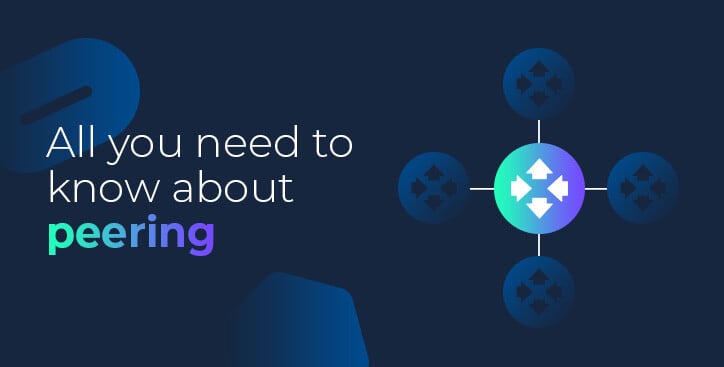All you need to know about peering
By Alex Hawkes|9 August, 2021

Topics:
Networking
By Alex Hawkes|9 August, 2021

Peering plays an essential role in the structure of the global internet. In this blog, we take a look at the different peering models available to organisations and explore some of the new ways they can access Internet Exchanges.
In a previous blog we looked at some of the advantages of using IP transit services. Whereas IP transit involves one company paying for the right to transit traffic across another network, IP peering is the mutual exchange of traffic between networks.
Peering is common among smaller regional network operators and broadband providers, as well as hosting companies, content delivery networks and content providers, who are looking to extend their global reach. Peering can help these types of companies lower their IP transit costs, while increasing overall network resiliency and redundancy.
By exchanging more traffic locally, peering can also help improve internet performance and speed for end users.
There are two main types of peering: public and private.
Public peering usually takes place at an Internet Exchange Point (IXP), where one network is able to peer with multiple other networks through a single connection. At an IX, an organisation can exchange traffic with a wide range of operators. This type of peering typically takes place at a shared colocation facility.
On the other hand, private peering is when two or more networks privately agree to exchange their traffic. Private peering often occurs between operators that need to exchange significant volumes of traffic, and typically take places at a privately-owned telecoms facility or a colocation facility.
Although public peering can be more complex than private peering, there are cost and performance benefits from using an IX.
There are hundreds of IXs located all over the world. What makes an IX attractive is its:
Three of the largest IXs include AMS-IX, DE-CIX and LINX, which between them are responsible for exchanging IP traffic between hundreds of Internet Service Providers (ISPs), network providers and content providers. To provide some greater context, DE-CIX locations around the world last year recorded an accumulated data traffic throughput of 32 Exabyte.
To access an IX, an organisation typically has to become a member and will need to install hardware at the exchange and then establish a connection to the site. In order to peer with other members, there might be other technical considerations, such as securing a publicly routed AS number or acquiring a block of public IP addresses.
Remote peering is also a popular option for accessing IXs. Remote peering enables an organisation to peer without a physical presence at the local exchange point by using bandwidth to extend a network’s reach to an IX.
It offers a more cost effective way for an organisation to directly access an IX, without the need for costly infrastructure at the exchange point and without having to contract separately with each IX.
Remote peering can be achieved via a service provider with an existing connection to an IX, and is increasingly being facilitated by automated Network-as-a-Service (NaaS) platforms that can manage both the peering and end-to-end connectivity.
Console Connect’s IX-as-a-Service (IXaaS) is making it easier for businesses to access leading IXPs worldwide.
IXaaS enables businesses to access IX services and remotely peer with leading IX partners in real-time and on-demand via the Console Connect digital platform.
There are a growing number of IX partners already available on the platform, including:
Using our management portal, Console Connect users can self-provision, manage and pay for their IX services and connectivity - consolidating the cost of both the dedicated layer 2 interconnection and remote peering at the Internet Exchange.
Unlike other remote peering providers, interconnections are delivered across our own high-performance global network, providing higher bandwidth options as well as delivering faster network speeds, greater security and lower latency.
Explore IX services from leading Internet Exchange providers across 20+ global locations via the Console Connect Marketplace.
©2025 PCCW Global. All Rights Reserved.